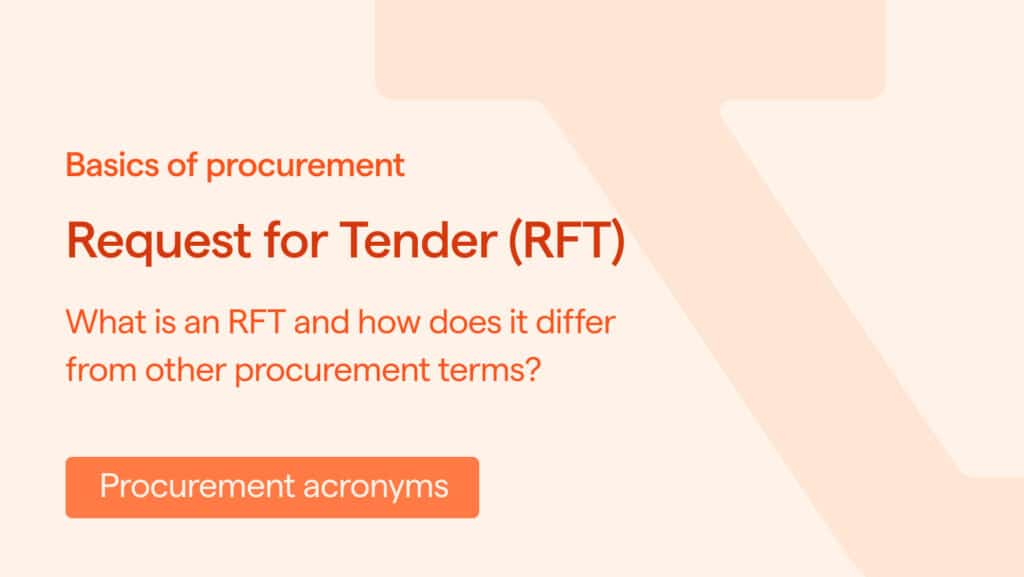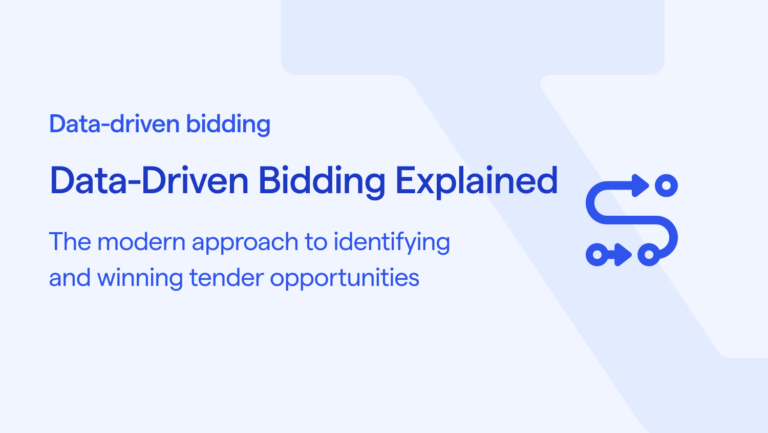It’s not easy to keep track of all the procurement terms and abbreviations. Request for Tender, or RFT for short, is one of the many you might come across when monitoring the public procurement market.
So what is an RFT? How does it differ from RFPs and ITTs? That’s what we’ll cover in this article.
An Introduction to Request for Tender
An RFT is, like all procurements, a formal request for potential suppliers, service providers and contractors to submit a proposal for the supply of goods, services, or works. RFTs are used by organisations to select the most suitable provider(s) for a particular project or contract.
The RFT process requires prospective suppliers to provide detailed information regarding their ability to meet specific requirements. This information typically includes details such as technical capabilities, pricing, and timelines. An RFT enables the procuring organisation to compare and evaluate the proposals and make an informed decision about who the most suitable supplier is for their particular needs.
RFT vs RFP: What are the differences?
A Request for Proposal, or RFP, is one of the most common terms that you may come across in working with procurements. If you’re familiar with RFPs, you might be wondering how an RFT differs from an RFP.
An RFT and an RFP have a lot of similarities, but also some differences. They are both procurements used to solicit bids or proposals from potential suppliers, vendors, or service providers. However, they serve slightly different purposes and are often used in different contexts.
Request for Tender (RFT):
- Focus: RFTs are typically used when the organisation has a well-defined project or product specification, and they are primarily interested in obtaining competitive bids based on their requirements.
- Detailed Specifications: RFTs often provide detailed specifications and requirements for the project, product, or service that the organisation needs. These specifications leave less room for creativity or alternative approaches.
- Evaluation Criteria: The presented evaluation criteria in an RFT are often more objective and price-oriented. The organisation is usually looking for the lowest-cost bid that meets all the specified requirements.
- Fixed Scope: RFTs often have a fixed scope, and the organisation may be less open to changes or modifications proposed by the bidding parties.
Request for Proposal (RFP):
- Focus: RFPs are used when the organisation has a broader project in mind and is seeking creative and innovative solutions. They are interested not only in price but also in the expertise and ideas that potential vendors can bring to the table.
- Flexibility: RFPs are generally more flexible in terms of the proposed solutions. Organisations may provide some guidance on what they want to achieve but allow bidders to propose how they will achieve it. This encourages vendors to suggest alternative approaches or technologies.
- Evaluation Criteria: RFPs often involve subjective evaluation criteria in addition to price. Factors like the vendor’s experience, approach, past performance, and the quality of their proposal may carry significant weight in the selection process.
- Scope Variability: RFPs may allow for some scope variability, meaning the organisation is open to negotiating changes or adjustments to the project scope based on the proposals received.
In summary, while both RFTs and RFPs are used for procurement, RFTs are more focused on obtaining competitive bids for well-defined projects with specific requirements, whereas RFPs are geared toward soliciting more creative and flexible solutions for projects that may require innovation and where the evaluation process considers factors beyond just price. Whether an organisation uses the term RFT or the term RFP depends on the organisation’s needs, the nature of the project, and the desired level of vendor involvement in shaping the solution.
An important caveat
Do note that in the vast world of procurement, buyers themselves are not always experts. As such, you might find that RFTs, RFPs, ITTs, and other processes are used and communicated interchangeably. An RFT can also, depending on what is to be procured, request more creativity – and an RFP can equally be slimmed down and more rigid in its request.
Moreover, different terms are used in different ways in different markets. So while it’s good to have a broad understanding of the meaning of these terms, it’s also important to be aware that the use of them will vary.
Are RFTs and ITTs the same?
If you’re already familiar with the term Invitation to Tender (ITT) – alternatively Invitation to Bid (ITB) or Invitation for Bid (IFB), as they’re also called – then the above description might sound familiar.
An RFT and an ITT are, in fact, terms that refer to more or less the same type of procurement. In many cases, the terms RFT and ITT are used interchangeably, and the differences between them are minimal or even nonexistent. However, in some regions or industries, there can be subtle distinctions:
Request for Tender (RFT)
Focus: RFTs are generally used to request competitive bids from potential suppliers or contractors. The emphasis is on obtaining competitive pricing for a specific project or procurement need.
Language and Terminology: The term RFT is more commonly used in certain countries, such as Australia. It is often associated with government and public sector procurement processes.
Invitation to Tender (ITT)
Focus: ITTs are also used to invite competitive bids from suppliers or contractors. Like RFTs, the primary focus is on obtaining competitive pricing for a specific project or procurement need.
Language and Terminology: The term ITT is more commonly used in the United Kingdom and some other European countries. It is commonly used for procurements in both the public and private sectors.
In practice, the differences between RFTs and ITTs are often regional or cultural, and the documents themselves typically serve the same purpose: to solicit bids or tenders for a specific project or procurement opportunity.
The specific requirements, evaluation criteria, and processes can vary from one organisation to another, regardless of whether they use the term RFT or ITT. Therefore, it’s essential to carefully review the procurement document and the organisation’s instructions to understand the specific requirements and expectations when responding to either an RFT or an ITT.
Find interesting RFTs and other procurements faster with Tendium
Do you want to locate and qualify interesting and relevant RFTs and other procurements efficiently? Are you seeking to simplify and streamline your overall bidding processes and increase efficiency? Give Tendium’s bidding platform a try! With automated summaries and smart workflows, our platform is improving procurement at each step. Book your free demo today.








